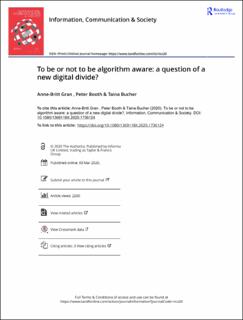| dc.contributor.author | Gran, Anne-Britt | |
| dc.contributor.author | Booth, Peter | |
| dc.contributor.author | Bucher, Taina | |
| dc.date.accessioned | 2022-03-17T10:20:18Z | |
| dc.date.available | 2022-03-17T10:20:18Z | |
| dc.date.created | 2020-03-09T13:07:35Z | |
| dc.date.issued | 2020 | |
| dc.identifier.citation | Information, Communication & Society. 2020, . | en_US |
| dc.identifier.issn | 1369-118X | |
| dc.identifier.uri | https://hdl.handle.net/11250/2985780 | |
| dc.description.abstract | Algorithms are an increasingly important element of internet infrastructure in that they are used to make decisions about everything from mundane music recommendations through to more profound and oftentimes life changing ones such as policing, health care or social benefits. Given algorithmic systems’ impact and sometimes harm on people’s everyday life, information access and agency, awareness of algorithms has the potential to be a critical issue. We, therefore, ask whether having awareness of algorithms or not corresponds to a new reinforced digital divide. This study examines levels of awareness and attitudes toward algorithms across the population of the highly digitized country of Norway. Our exploratory research finds clear demographic differences regarding levels of algorithms awareness. Furthermore, attitudes to algorithm driven recommendations (e.g., YouTube and Spotify), advertisements and content (e.g., personalized news feeds in social media and online newspaper) are associated with both the level of algorithm awareness and demographic variables. A cluster analysis facilitates an algorithm awareness typology of six groups: the unaware, the uncertain, the affirmative, the neutral, the sceptic and the critical. | en_US |
| dc.language.iso | eng | en_US |
| dc.rights | Attribution-NonCommercial-NoDerivatives 4.0 Internasjonal | * |
| dc.rights.uri | http://creativecommons.org/licenses/by-nc-nd/4.0/deed.no | * |
| dc.title | To be or not to be algorithm aware: a question of a new digital divide? | en_US |
| dc.type | Journal article | en_US |
| dc.type | Peer reviewed | en_US |
| dc.description.version | publishedVersion | en_US |
| dc.source.pagenumber | 18 | en_US |
| dc.source.journal | Information, Communication & Society | en_US |
| dc.identifier.doi | 10.1080/1369118X.2020.1736124 | |
| dc.identifier.cristin | 1800618 | |
| dc.relation.project | Norges forskningsråd: 247602 | en_US |
| cristin.ispublished | true | |
| cristin.fulltext | original | |
| cristin.qualitycode | 1 | |

